
‘Conflict with the Ghazees before Bareilly’, 1857
The Uprising of 1857 was India’s first widespread struggle against the British government. Even though it wasn’t a struggle for sovereignty, it planted the desire for freedom in indigenous minds and shook up the very foundations of British rule in India. An early nationalist perspective on the events of 1857 was offered by VD Savarkar, who termed the Revolt as ‘India’s First War of Independence’.
It is difficult if not impossible to fully map the breadth, scope and aftermath of the rebellion of 1857; its echoes were lingering and far-reaching. The study I have attempted here focuses on specific events and regions, and uses the Sarmaya collection to go beyond the dates and numbers to tell the story of a revolution.
Tension in the ranks
By the nineteenth century, the British had largely consolidated their hold over the Indian subcontinent. Territories like Bengal, Awadh and Mysore had been cleverly brought under British control through tactful annexations and alliances. Political and administrative control was accompanied by reforms in the socio-cultural and military realms to simplify and improve governance and ‘civilise’ the natives. Such measures—the abolition of sati, adoption of English as the language of instruction, reorganisation of the military system of privileges—hurt native sentiments, as they hit at revered social and religious structures. In the period immediately preceding the Revolt, these factors became more pronounced, sparking widespread dissatisfaction.
Besides this, concessions granted by the government in the past —the passing of sepoy letters free of postage tax and the personal role of soldiers in determining promotions and overseas service—came to be seen by the soldiers as their rightful privileges. The sudden withdrawal or curtailment of these, coupled with the inability of their European officers to communicate the reason for this in the language of the soldiers, became the primary grievance of the native troops.
But what acted as the final trigger for the Uprising was the introduction of the Enfield rifle. The bullets of the rifle had to be bitten before firing, and they were rumoured to be greased with the fat of cows and pigs, which was hurtful to the sentiments of Hindus and Muslims. Given their growing disillusionment with the Empire, the Bengal army found it plausible that the British would use such insidious means to ‘Christianise’ them. The rage of the soldiers bubbled over and led to the burning of a telegraph office on 24th January 1857 in Barrackpore. A government order to repeal cartridges only fuelled the fire; it was assumed that the rumours about the cartridges was true, and other secret attacks on Indian caste would be launched.
League of the extraordinary
Although the British did their best to downplay the scale of rebellion and project it as chaotic and unplanned, the works of nationalist writer Rudrangshu Mukherjee suggest otherwise. These prove that while the revolt itself may have been sparked by mutinies in the sepoy lines, it took some organisation to carry forward the struggle. There existed a pattern in the order the mutinies were carried out; the firing of the evening guns in Meerut, Lucknow and Bareilly occurred as if part of a chain reaction.
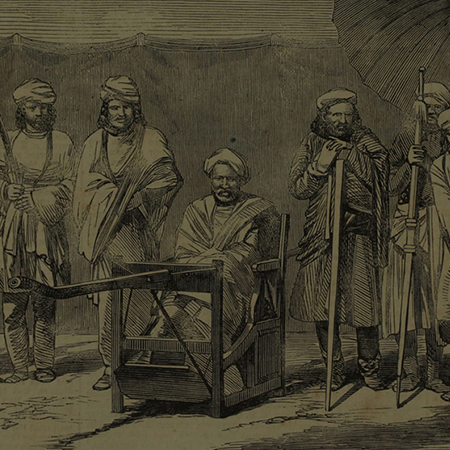
Kuwar Singh of Arrah, 1857, monochrome engraving on paper, The Illustrated London News © Sarmaya Arts Foundation (2015.3.9) — click on image for more
The Revolt appears to have been a popular uprising that drew diverse leadership, cutting across geographical and social differences: Kunwar Singh from Bihar, Nana Sahib from Kanpur, the aged Mughal emperor Bahadur Shah Zafar II from Delhi, and the warrior-queen Rani Lakshmibai from Jhansi. What is interesting is that many such men and women were forced into positions of importance—they were called upon by the masses to take charge of the movement and didn’t get much say in the matter. Kunwar Singh, for one, was nearly 80 and in poor health when he was called upon to take up arms. He assumed command of the soldiers of Danapur on 25 July, following which he fought battles in Arrah, Lucknow, Azamgarh and Jagdishpur. Before his final battle, Singh cut off his left hand to prevent the threat of infection after a bullet shattered his wrist. A few months later, on April 23, 1858, this venerable warrior was killed by British troops near Jagdishpur.
Mutiny at Meerut
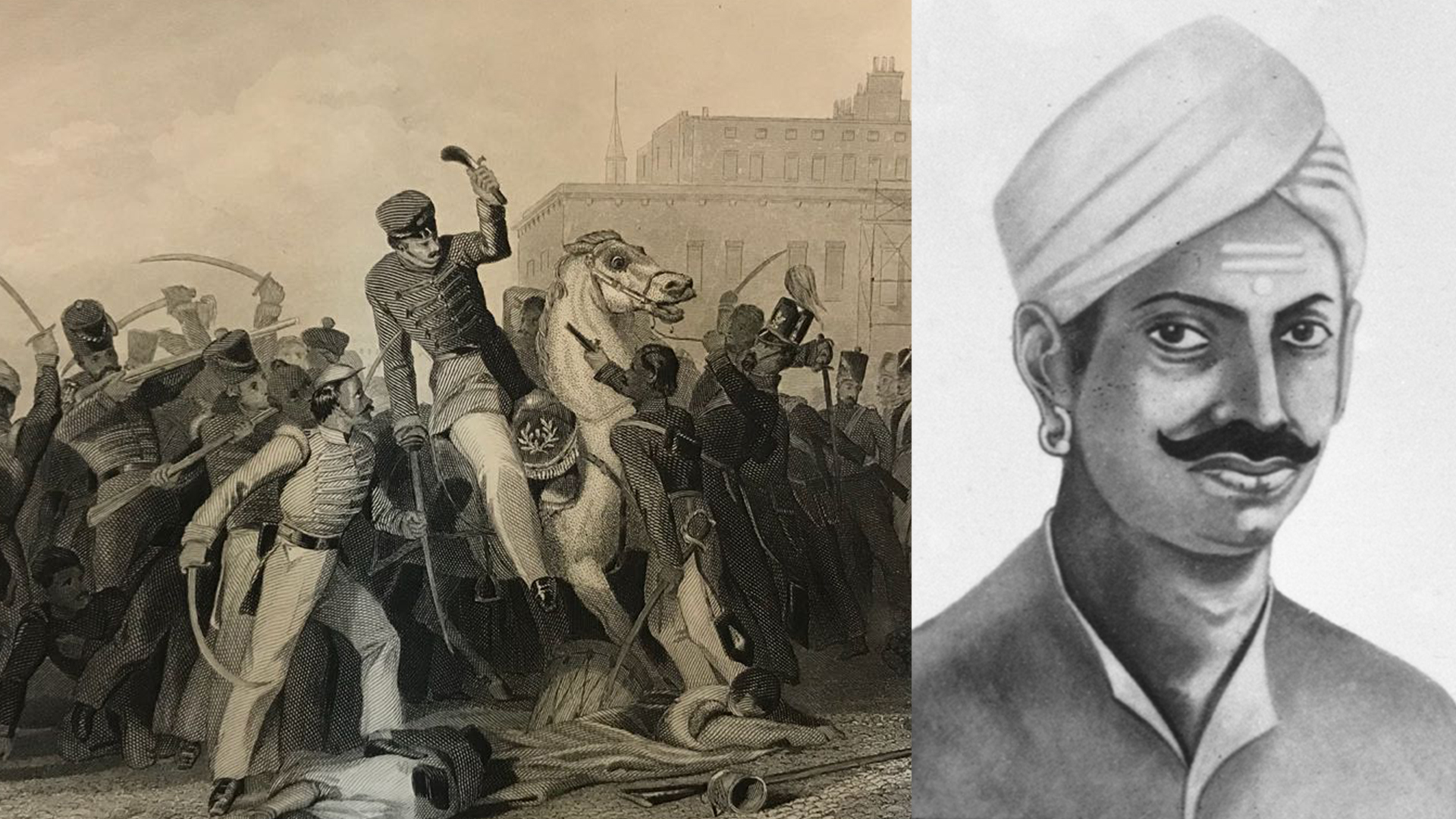
Left: Death of Colonel Finnis at Meerut, from Sarmaya’s collection of engravings; right: Mangal Pandey, Flickr/Public.Resource.Org
The mutiny of 1857 began in Barrackpore under the leadership of the sepoy Mangal Pandey of the 34th Regiment and ended with the killing of Sergeant Major Hewson and the injury of Lieutenant Baugh. Pandey was eventually hanged, which, coupled with the disbandment of the 29th Regiment, brought an end to the mutinous spirit at Barrackpore and Behrampore. However, discontent soon cropped up in districts like Sealkote, Agra, Ambala, and, most importantly, Lucknow.
Simultaneously, in Meerut, disaffection was more plainly visible than in any other station of the North-Western Frontier Provinces. On 10th May, 1857 the Bengal army revolted at the sounding of the fire alarm and the bugle. Once the alarms went off, the 3rd Light Cavalry and the 20th Native Infantry rushed out of their lines, fully armed, releasing inmates in prison, burning buildings and killing British officers and other Europeans.
Battle for Delhi
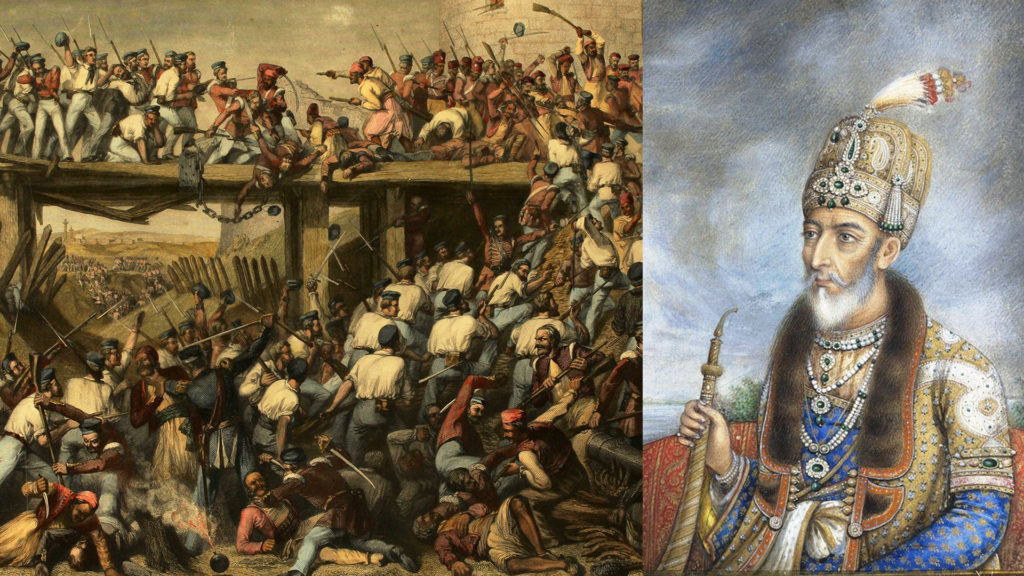
Left: Storming of Delhi, from Sarmaya’s collection of engravings; right: Bahadur Shah Zafar, Wikipedia Creative Commons
On the morning of 11th May, the news of Mangal Pandey’s execution and the subsequent disbandment of his regiment reached the Delhi sepoys. This produced much muttering in the ranks. Soon after, the rebels from Meerut arrived in the capital, forcing Bahadur Shah Zafar II, the aged Mughal emperor, to take up leadership of the Revolt, which he did reluctantly. Under Company rule, Delhi’s position had been undermined, and hence was not a station for any units of the British army, which simplified its takeover by the rebels considerably. The British plan to fight the rebels by launching an attack from Cashmere Gate in Delhi was jeopardised by the betrayal of the 54th Regiment, which immediately joined the rebels, leaving the British to be mercilessly killed. Delhi, as will be shown, was taken over with ease by the troops, who quickly gained fresh recruits from the 38th and 74th Regiments. The reason behind the mutineers’ march to Delhi was the unique position held by the city as the Mughal capital, making the breakdown of British law and order here symbolic of complete victory over the British. The Company officials made desperate attempts to close off all city gates, but failed to prevent the entry of raging rebels through the Rajghat Gate. The events that followed over the next few days involved the slaughter of British officials and civilians. With the continuous arrival of large contingents of rebellious sepoys in Delhi, it quickly became apparent to the British that the city was too well-fortified and strongly held to fall to a swift attack. The mutineering sepoys carried out attacks through June and July, the major ones being the attacks of 19th June, 23rd June and 9th July, in which the besiegers were bogged down by heavy losses.
In early August, the besiegers found necessary reinforcement in numbers and arms by the arrival of Brigadier John Nicholson and his forces, joined by a siege train in early September. Immediate action was decided upon, led by Richard Baird Smith, an engineer officer, who drew up elaborate plans to breach the city walls and make an assault—every column was to launch its attack from a different place. The operations of this phase of the British siege resulted in a part of the walls of Delhi falling back into British hands, first the Cashmere Gate region, followed by the Magazine, the Palace and Jama Masjid, and Lahore Gate.
On 21 September, the city was finally declared captured, but at a terrible cost; not only did British officials like Nicholson and native sepoys lose their lives, but innocent civilians did too. By recapturing the Indian capital city, the British and Company forces dealt the Indian Army mutineers a major military and psychological blow. Bahadur Shah and his three sons were captured by Major William SR Hodson, leader of the irregular Light Cavalry at the time, who had the latter executed. The emperor was spared but exiled to Rangoon. Hundreds of rebel prisoners, suspected rebels and sympathisers were hanged without trial or legal process.
Carnage in Kanpur
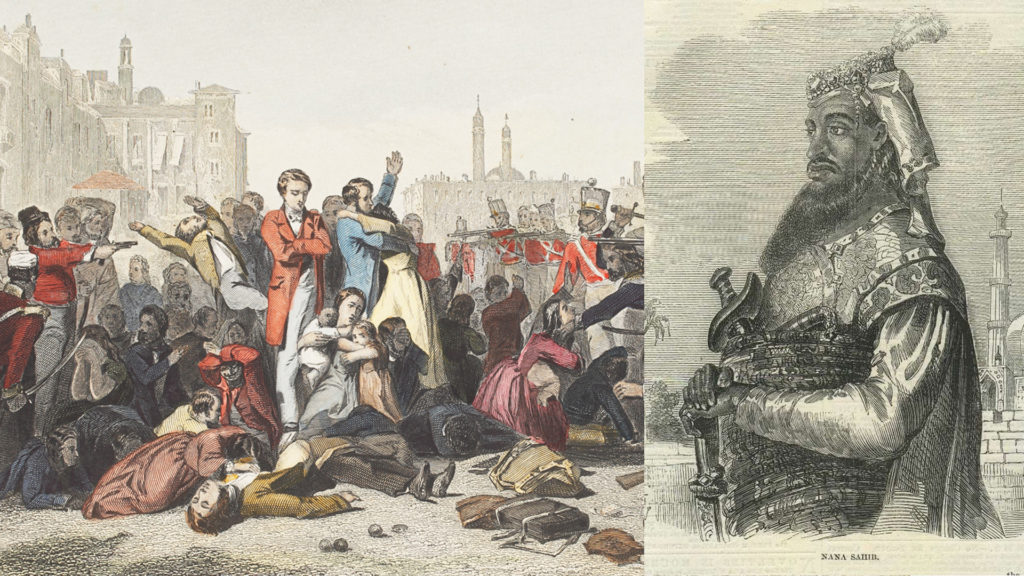
Left: ‘Massacre at Cawnpore’, engraving from the Sarmaya collection; right: Nana Sahib, Wikipedia Creative commons/Illustrated London News
The revolts at Meerut and Delhi provided the necessary inspiration for a general rising across India, first in Ferozpore, Aligarh, Etawah and Mynpoorie, and later in Benares, Allahabad, Kanpur, Awadhi and Rohilkundi provinces. Of these risings, the ones at Kanpur and Lucknow were the most significant. By end May-early June, the British forces in Kanpur had been reinforced: a month’s provisions had been stored in the entrenchment and additional guns strategically positioned. The rebellion broke out on the night of 4th June, led by the 2nd Cavalry and joined by the forces of Nana Sahib, the adopted heir of Baji Rao II, former peshwa of the Maratha Confederacy. As Nana was not a natural-born heir, the Company had decided to cancel the transfer of pension and honours of the lineage to him. He took up residence in Kanpur to excite the sepoys into revolt and protect the treasury himself. The 2nd Cavalry and Nana’s men were quickly joined by the 1st Native Infantry and the native artillerymen of the Awadh Battery.
The aim of all groups of insurgents was to make their way to Delhi and join the other rebels. This, however, posed a challenge to Nana Sahib, as the departure of the mutineers for Delhi would mean that the advantages he had promised himself from the Revolt—the restoration of the Peshwa and Maratha with Kanpur as the centre of sovereignty—would be lost. He therefore made every effort to persuade the marching troops to return to Kanpur and kill the Britishers left behind, in order to secure their own lives, which would be threatened if the rebellion were unsuccessful. The news of more treasure in the entrenchment and the gunpowder and guns remaining in the magazine gave the rebels added incentive to place themselves under Nana’s orders and return to Kanpur.
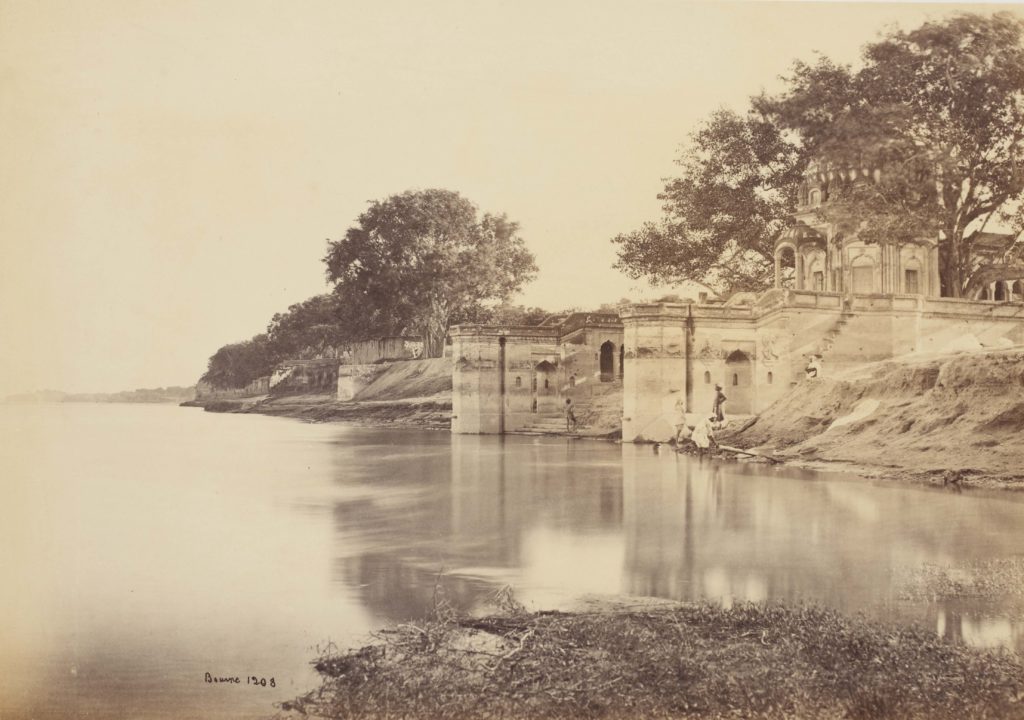
Satichaura Ghat, a photograph by Samuel Bourne
On 25th June, the British surrendered, giving Nana control over government money, the magazine and guns, in return for the safe passage of the surviving English families to Allahabad after a day of preparation and burying their dead. On the 27th, carts and elephants were sent by Nana to enable British women, children and the sick to proceed to the river banks, from where they would be taken to Allahabad. The British officers and military men were allowed to take along their arms and ammunition, and were escorted by a large portion of the rebel army. As soon as the British party reached Satichaura Ghat and set aside their musketry, however, they were once again attacked by sepoys. Although the British hold him responsible, there is no evidence to prove that Nana Sahib had pre-planned or ordered the massacre.
Some modern historians suggest the Satichaura Ghat massacre was the unfortunate result of some confusion. Nevertheless, the departing Britishers were killed and captured by rebel sepoys, and the few boats that escaped, including Wheeler’s, were pursued and attacked. Even those who surrendered were captured and taken to be fired on. The women and children survivors of the Satichaura Ghat massacre were placed in captivity in Kanpur, first at Savada House and then at Bibighar. The prisoners were placed under the care of a sex worker, Hussaini Khanum, and used to bargain with the Company, whose armed forces, led by Henry Havelock and Colonel James Neill, had set out from Allahabad to retake Kanpur and Lucknow.
Nana’s demand for the retreat of the relentlessly advancing Company forces was ignored. It was clear that his bargain had failed and drastic action needed to be taken. When the rebel leaders of Kanpur received news of violence against innocent Indian villagers by Havelock’s and Neill’s forces, they issued an order on 15th July to murder the women and children imprisoned at Bibighar, after much discussion. A merciless murder of the innocent took place once more, with every kind of weapon, from bayonets to clubs to butcher’s knives to battle-axes. Once everyone had been killed, the butchered corpses were then thrown into a well.
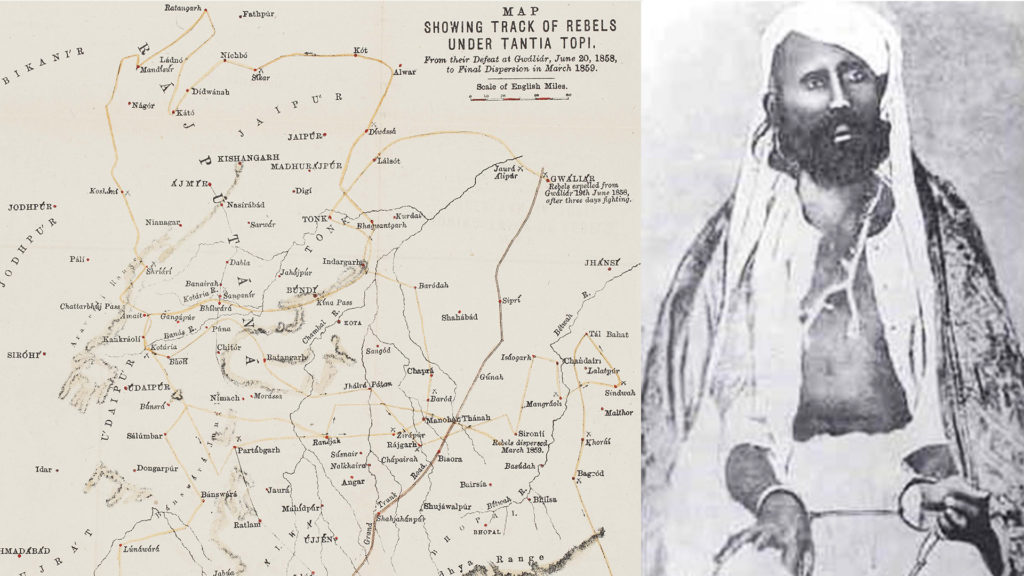
Left: Map showing track of rebels under Tantia Topi from the Sarmaya collection; right: Tantia Tope, Wikipedia Creative Commons
The British troops arrived at Bibighar on 16th July, only to find the captives murdered brutally. Infuriated and disgusted, they engaged in a surge of violence against the local population of Kanpur, their justification being that the local noncombatants did nothing to prevent the massacre. The fate of Nana Sahib remains unknown, but the British claimed that he was captured. Slowly, order was restored in Kanpur. A final attempt at recapture by the rebels was led by Tatya Tope in November, but his army of rebel soldiers from the Gwalior contingent were defeated by the Company forces commanded by Sir Colin Campbell in the Second Battle of Kanpur, concluding the phase of rebellion in the Kanpur area.
A fault-line grows
The events of 1857 led to the death of thousands, with estimates placing this number somewhere between 800,000 and 1,000,000. Both sides committed brutalities and atrocities against civilians, although the numbers of those who suffered were far greater on the rebel side. Given the magnitude and scale of the rebellion, not only in terms of these numbers but also its spread geographically and socially, it was obvious the Revolt would not be forgotten easily.
Two things happened immediately in its aftermath. First, the British cracked down heavily in punishment. The events of 1857 left the colonisers feeling embittered and angered, sentiments that were expressed in the journals and diaries of the time. The graphic portrayal of the mutilation and violence wrought against women, children and the wounded, horrified and enraged the British public, making them wholeheartedly support the desire of their soldiers who sought revenge. Indian rebels were brutally punished by hanging or by being blown to pieces from cannons.
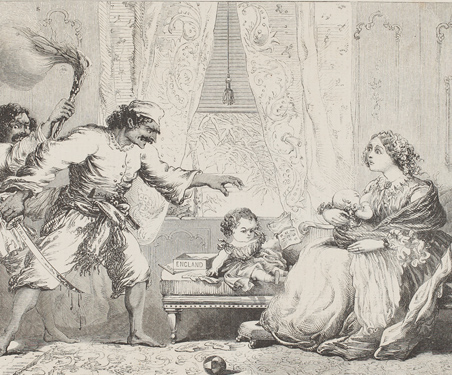
‘English Homes in India
1857′, Monochrome Engraving on Paper, Illustrated Times © Sarmaya Arts Foundation (2017.4.88) — click on image to see more
The second, more interesting shift happened in the attitudes of the colonial masters towards their subjects and vice versa. Politically, the nature of British rule in India underwent a transformation. The issuing of the Government of India Act of 1858 marked the transfer of the East India Company’s ruling powers to the British Crown. Administrative policy in India was now formulated and implemented by the new government department called the ‘India Office’ and its head, the Secretary of State for India, and the Governor-General, under the new title Viceroy, respectively.
In 1877, Queen Victoria took up the title of Empress of India. Colonial administrators dedicatedly pursued the path of reform, giving up their earlier attempts at Westernisation. They adopted a tolerant stance on religion and incorporated those from Indian upper and ruling castes into the government. Although the old Company bureaucracy essentially remained, attitudes underwent a drastic change—a new philosophy that stressed the preservation of tradition and hierarchy took shape. This was rooted in the belief that the causes of the Revolt lay within the spheres of religion and economy. With respect to religion, the British believed there was earlier an excessive interference in indigenous traditions. On the matter of economy, it was stated that the Company’s attempts to create an environment of free market competition had undermined traditional power structures and bonds of loyalty, placing the peasantry at the mercy of merchants and money-lenders. Politically, it was felt that the severity of relations between the rulers and ruled created a wide gap that fomented unrest.
As a direct result of this school of thought, Indians were drawn into the government at a local level, albeit on a limited scale. This, along with the opening of universities at Calcutta, Bombay and Madras created a new professional middle class, members of which would be drawn to the early mission of the Indian National Congress. Founded in 1885 by two Parsi industrialists and a retired British civil servant, the Congress started off as a platform that would debate the issues of the day and put the concerns of Indian citizenry before its rulers in England. By the early 20th century, the party would be at the forefront of the freedom struggle, led by personalities who are known today as the founders and architects of free India.
In the end, the events of 1857 were never to be India’s ‘tryst with destiny’. But in the aftermath, an awareness grew among the masses, who had learned to fight for what was rightfully theirs. The Uprising planted the embers of defiance that would feed the blaze in which our national identity was forged less than a century later.
A student of history from St Stephen’s College, Devika Dua had interned with Sarmaya
* * *
BIBLIOGRAPHY
- Forbes-Mitchel, William; Reminiscences of the Great Mutiny; Macmillan and Co.; London, 1894
- Gubbins, Martin Richard; An Account of the Mutinies in Oudh and of the Siege of the Lucknow Residency, Woodfall and Kinder; London; 1858
- Lady Inglis; The Siege of Lucknow: a Diary; James R Osgood, McIlvaine and Co.; London; 1892
- NCERT, Themes in Indian History Part III
- Pati, Biswamoy; The 1857 Rebellion, Debates in Indian History and Society; Oxford University Press; 2007
- Rees, L.E.R.; A Personal Narrative of the Siege of Lucknow, From its Commencement to its Relief by Sir Colin Campbell; Spottiswoode and Co.; London; 1858
- Sedgwick, F.R.; The Indian Mutiny 1857, A Sketch of the Principal Military Events; Forster Groom & Co Ltd.; London; 1920
- Unknown; The Mutiny of the Bengal Army; An Historical Narrative, Bosworth and Harrison; London
- Indian Mutiny of 1857 – Siege of Delhi



